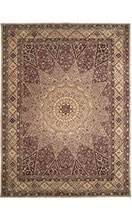
Types of Rugs
Texture, appearance, cost & quality are determined by the methods used, materials used and time spent constructing a rug. To help narrow your options, take a look at the unique features of these common rug types.
Rug Construction
Most rugs are made with the same techniques that have been used for hundreds of years. The finest handwoven rugs require considerable time and attention to detail. And while machine-made rugs can be made more quickly, the same design aesthetic remains in place.
Hand-Knotted Rugs
- Individual knots are hand tied using a loom
- Most commonly made using wool and/or silk materials
- Highly rated for their durability & long lifespan
- Most labor-intensive method of construction

Hand-Tufted Rugs
- Loops of yarn are fed through a base canvas to create a pattern
- Sheared to produce a plush, cut-pile surface
- Labor-intensive but affordable compared to hand-knotted rugs

Hand-Hooked Rugs
- large or large loops of fabric or yarn are fed through a stiff base canvas (like burlap or linen)
- A design is printed on the base canvas and the fabric/yarn creates the pattern or texture
- Similar to hand-tufted rugs but affordable compared to hand-knotted rugs

Machine-Made Rugs
- Manufactured with computer-driven power looms
- Most commonly made using synthetic materials like polypropylene, polyester or nylon
- Lower-cost alternative to hand-knotted rugs
- Highly rated for resilience & long lifespan and affordability

Braided or Flat-Weave Rugs
- Woven or braided onto a loom like a cloth with no base canvas
- Most commonly made using flat-weave materials like wool, jute and cotton
- Ideal for more casual settings
- Commonly reversible

Rug Materials & Fibers
From natural to synthetic, every fiber or fabric has its own characteristics & advantages. How your rug looks, feels & performs is dependent on the materials used.
Natural Fibers
Rugs made with natural fibers have distinctive features unique to their material.
Shop Natural Fiber Rugs
Wool
Wool is one of the best natural fibers to use for rugs. It's highly regarded for its strength, durability and vibrant details.
Shop Wool Rugs
Grass Fibers
Jute and sisal are common examples of natural grass fibers. These fibers are generally flat-woven to produce extremely strong, durable rugs.

Synthetic Fibers
Synthetic, or man-made, fibers are created from materials such as polypropylene, acrylic and viscose. These materials are often used to mimic the characteristics of natural fibers, but can be more allergy and pet-friendly.
Polypropylene
Affordable, fade-resistant & inherently resistant to moisture-based stains, it's a great option for indoor and outdoor.
Shop Polypropylene Rugs
Acrylic
With its ability to produce vivid patterns & mimic the plush qualities of wool, acrylic is a great material option for luxury-seekers on a tight budget.

Viscose
This shiny fiber is commonly used as an affordable substitute for silk.
Rugs can be made entirely of viscose or use viscose to create an accent.
